Crossbreeding the cavalier King Charles spaniel
-
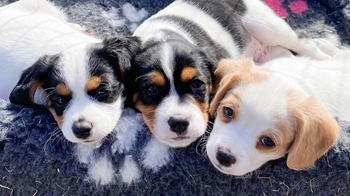 What It Is
What It Is - Donor Breeds
- History of Crossbreeding
- The LUA Dalmatians
- Current Crossbreeding Projects
- Alternative to Crossbreeding
- Veterinary Resources
The national kennel clubs in three countries recently have embarked upon programs to introduce genetic variation into the cavalier King Charles spaniel breed by crossbreeding cavalier breeding stock with other breeds.
What It Is
Crossbreeding, also called outcrossing and backcrossing, is the mating of one breed, in this case the cavalier King Charles spaniel (CKCS), with a different breed, called the donor breed, to introduce genetic variation in the CKCS breed. All of these crossbreeding programs discussed here are approved in advance by national kennel clubs and CKCS clubs. They do not include crossbreedings to create "designer dogs" such as cavapoos or the like.
The primary purpose of crossbreeding the cavalier is to deal with specific genetic health issues, in particular mitral valve disease (MVD) and syringomyelia (SM), both of which are extremely prevalent in the CKCS. The ultimate goal is to increase genetic variation and improve health in the cavalier.
Once a litter of puppies is produced from the mating of the cavalier and the donor, then pups from that litter are "backcrossed" by being bred with other purebred cavaliers. Theoretically, the offspring of the first cross litter need not be crossbred with another donor dog.
RETURN TO TOP
Donor Breeds
Donor breeds are intended to be:
• not closely related to the CKCS;
• free of the most common hereditary disorders of the CKCS;
• have temperament and behaviors similar to the CKCS;
• be similar in size to the CKCS.
In these crossbreeding programs described below, the donor dog breeds include:
• Tibetan terrier
• Lhasa Apso
• Danish-Swedish farmdog
• Papillon
• Phalene
• Beagle
• Moyen poodle
• Japanese spitz
• Mittelspitz (medium sized German spitz)
• Kleinspitz (miniature sized German spitz)
RETURN TO TOP
History of Crossbreeding
Many current pedigree dog breeds were created by crossbreeding. Purposes of crossbreeding certainly have varied, with many efforts to result in such things as an increase of useful traits (hunting, flushing, herding, as examples), increase or decrease in overall size at maturity, produce different types of coats (waterworthy, such as the Chesapeake Bay retriever). Significantly for our purposes, it has been a proven method of breeding away from hereditary disorders that have become widespread in a purebred breed.
 Images of English toy spaniels (King Charles spaniels - KCS) over the
past 500 years have suggested that the breed underwent significant
crossbreeding, from much smaller adults with narrow, pointy muzzles to
the larger bodied, short muzzled and dome-headed KCS of the 1920s, and
remain the KCS breed standard of today.
Images of English toy spaniels (King Charles spaniels - KCS) over the
past 500 years have suggested that the breed underwent significant
crossbreeding, from much smaller adults with narrow, pointy muzzles to
the larger bodied, short muzzled and dome-headed KCS of the 1920s, and
remain the KCS breed standard of today.
For example, the 1651 painting at the right is of King Charles II of England, for whom the KCS breed is named. He is holding on his lap an English toy spaniel that appears to be significantly smaller than the 21st Century version of the cavalier, and its head, particularly its muzzle, is quite different in shape than our current breed.
Rumors abound of crossbreeding KCSs with pugs and similar breeds in past centuries. These crossbreedings of the past, if they occurred, unlikely were performed for genetic diversity or any health reasons at all.
RETURN TO TOP
• The LUA Dalmatians
A most recent example of successful health-purpose crossbreeding is the Dalmatian. By 2010, it was reported that 100% of Dalmatians registered with the American Kennel Club (AKC) carried a mutated gene causing high uric acid and urate stones, particularly in males. The affected gene, a mutated version of the SLC2A9 gene, was causing exceedingly high levels of uric acid – about ten times that of a normal dog. The disorder had been detected in the early 1900s. In research studies in the last half of the 20th Century, high majorities of males were found to have uric sediment in their bladders, and an estimated 13% to 34% produced potentially painful urate stones which can cause blockages and which may require repeated surgeries to remove.
In 1973, Dr. Robert Schaible (right), a geneticist and Dalmatian breeder,
began a crossbreeding program to
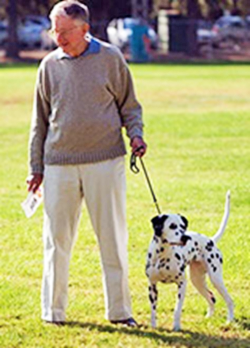 eliminate the high uric acid mutated
gene in the breed. He bred a male pointer to a Dalmatian once. That
single mating produced offspring with the normal SLC2A9 gene. He then
backcrossed those offspring having normal genes with Dalmatians,
producing 14 generations and over 10,000 dogs, which became known
as Low Uric Acid (LUA) Dalmatians. By pedigree analysis, the 14th
generation version of the LUA Dalmatian was 99.998% pure Dalmatian.
eliminate the high uric acid mutated
gene in the breed. He bred a male pointer to a Dalmatian once. That
single mating produced offspring with the normal SLC2A9 gene. He then
backcrossed those offspring having normal genes with Dalmatians,
producing 14 generations and over 10,000 dogs, which became known
as Low Uric Acid (LUA) Dalmatians. By pedigree analysis, the 14th
generation version of the LUA Dalmatian was 99.998% pure Dalmatian.
Notwithstanding all of this evidence, the AKC's parent club for Dalmatians, the Dalmatian Club of America (DCA), repeatedly refused to allow LUA Dalmatians to be registered with the AKC. In 2010, the AKC's board of directors took all of the background evidence into account and called upon the DCA's membership to vote to admit LUA Dalmatians to the registry, or the AKC board would take matters into its own hands, so to speak. The DCA finally succumbed, and since 2011, LUA Dalmatians began to be registered with the AKC as Dalmatian purebreds.
A seldom spoken of downside of this single mating of a Dalmatian with a pointer is that the gene pool of the 10,000+ descendants likely would be very small. Had several Dalmatians from several bloodlines been bred to several donor pointers of several bloodlines, the narrow gene pool issue would have been avoided. But, possibly, the backcrossing of that first litter with several Dalmatians of other bloodlines, avoided that potential "bottleneck" of the gene pool. The current national kennel club crossbreeing programs encourage many cavalier breeders to participate in crossing their breeding stock with other approved breeds, to widen the gene pool and avoid such bottlenecks.
RETURN TO TOP
Current Crossbreeding Projects
Three national kennel clubs and their CKCS clubs -- those of Sweden, Norway, and Finland -- have crossbreeding projects underway for the cavalier King Charles spaniel.
Finland
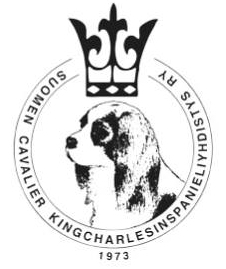 The national cavalier King Charles spaniel club in Finland (Suomen
Cavalier Kingcharlesinspanieliyhdistys) decided to begin its
CKCS
croosbreeding project in April 2022. At that time, the club explained:
The national cavalier King Charles spaniel club in Finland (Suomen
Cavalier Kingcharlesinspanieliyhdistys) decided to begin its
CKCS
croosbreeding project in April 2022. At that time, the club explained:
"The cross-breeding programme’s goal is to improve the health of the breed, particularly regarding Mitral Valve Disease, Syringomyelia and possibly even Chiari Malformation. The Finnish CKCS Club recognises that particularly MVD is fixated in the breed and thus traditional Cavalier x Cavalier breeding cannot eradicate the condition nor notably decrease the number of affected dogs. Cross-breeding will introduce Cavalier with genetic material from another breed that is free from these severe health conditions, increasing CKCS’s genetic diversity. The breed club’s plan is to carry out several litters with several breeds, in order to see long-term health results and to ensure sufficient material for further study.
"Regarding partner breeds, no final decisions have yet been made. However, there are set guidelines, such as the partner breed must not show any brachycephalic traits, and its temperament must match that of the typical CKCS. All eventual cross-bred CKCS litters will be bred by registered CKCS breeders under the supervision of The Finnish Kennel Club and the Finnish CKCS Club. A single cross-bred line will include four generations, the final one being FCI registered as purebred Cavalier King Charles Spaniel. Completing a single 4 generation line is estimated to take approximately 10 years."
On April 23, 2022, the membership of the Finnish Cavalier King Charles Spaniel Club unanimously approved the start of a croos-breeding program between purebred CKCSs and one or more other breeds which are free of the CKCS genetic disorders of early-onset mitral valve disease (MVD), syringomyelia, and Chiari-like malformation.
All eventual cross-bred CKCS litters will be bred by registered cavalier breeders under the supervision of both the Finnish Kennel Club and the Finnish CKCS Club. A single cross-bred line will include four generations, the final one being FCI registered as purebred cavalier King Charles spaniel. Completing a single 4-generation line is estimated to take approximately 10 years.
On June 15, 2023, the Finnish Kennel Club accepted cross breeding projects for the CKCS breed, stating:
"The selected breeds for cross breeding the Cavalier are the Tibetan Terrier, the Danish-Swedish Farmdog, the Papillon/Phalene, the Beagle and possibly the Moyen poodle and the Japanese Spitz. These breeds are seen suitable based on their behaviour and character, and they are not known to have same or similar health issues than the Cavalier. The breed profile may still be changed during the project. It may be considered case-by-case how wide the health examinations should be for the mating partner."
On April 26, 2025, the Finnish Cavalier Club announced that the Finnish Kennel Union has approved the Mittelspitz (medium sized German spitz) and the Kleinspitz (miniature sized German spitz) as crossbreeds for the cavalier crossbreed program.
The website for Finland's project is linked here.
RETURN TO TOP
Norway
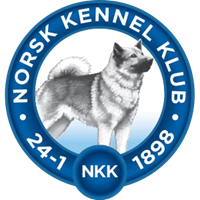 The Norsk Kennel Club
(NKK) published its CKCS crossbreeding program
details in April 2025. It states as it priority breeding goals:
The Norsk Kennel Club
(NKK) published its CKCS crossbreeding program
details in April 2025. It states as it priority breeding goals:
• Completely eliminate syringomyelia (SM) in the short term and chiari-like malformation (CM) in the somewhat longer term;
• Reduce the incidence of myxomatous mitral valve disease (MMVD) in general, and in particular eliminate cases of valvular disease in young dogs;
• Maintain a good "Cavalier temperament";
• Keep other health challenges under control.
The breeding guidelines for the cavalier include:
1.1 General: Purebred CKCS cannot be mated to each other.
1.2 Age: Dogs must be at least 3 years old at the time of mating.
1.3 General clinical examination: Dogs must undergo a general clinical examination before being used in breeding for the first time. Dogs must not be used in breeding if the veterinarian advises against it.
1.4 Syringomyelia (SM): Dogs must be MRI-scanned at least once after reaching the age of 3 years. Only dogs with a result of SM0 or SM1 can be used in breeding. Dogs with SM1 can only be used in breeding if they are mated to a purebred dog of another approved breed (i.e. they cannot be part of a backcross).
1.5 Heart certificate: Before breeding, and after the age of three, dogs must undergo a heart examination including ultrasound according to the NFVK protocol, conducted by a veterinarian approved by the NKK/NFVK. The certificate is initially valid for one year. For breeding approval due to heart status, the following applies: If a dog is heart examined with the result "Normal" or "MMVD equivocal"1 after the age of 3, it is approved for breeding heart status for up to 122 offspring until it reaches the age of 5. If a dog is heart examined with the result "Normal" or "MMVD equivocal"1 after the age of 5, it is approved for breeding heart status for a further 122 offspring until it reaches the age of 7. If a dog is heart examined with the result "Normal" or "MMVD equivocal"1 after the age of 7, it is approved for breeding heart status for the rest of its life. For male dogs with CM0, a general dispensation is granted for the use of dogs with up to grade B1 according to the ACVIM classification when examined after the age of 7 years. For bitches, pregnancy with incipient valvular disease entails a risk of deterioration - therefore, a B1 result is not approved in bitches, regardless of age. The heart certificate is always valid for a minimum of one year. This means that if a dog is examined when it is, for example, 4.5 years old, it must not be examined again until it is 5.5 years old, even if it moves into the "over 5 years" group before that. The number restrictions apply regardless. If a dog is detected with a murmur between ultrasound examinations, for example in connection with a routine check-up at the veterinarian or vaccination, it must be excluded from further breeding. 1 MMVD equivocal: No audible murmur, no or minimal subjective thickening of the valve, prolapse 2 mm or less, mitral leakage assessed with color Doppler fills <15% of the LA area 2With a limit of 12 offspring it is meant that as long as the dog has 11 offspring or fewer, it can be mated again, and the entire litter will be registered. The limits can be "accumulated", so that a dog can have more offspring later if it does not have many offspring while young.
1.6 DNA collection for research purposes: Before breeding, a DNA sample from the dog must be sent to NMBU Veterinary School, for storage and use in future research for the best of the breed. All information about the dog will be treated confidentially in this context. The samples can also be used for DNA testing if relevant tests related to health challenges in the breed become available at a later date. As of June 2023, DNA samples have been collected in connection with MRI scans. For dogs that have been MRI scanned earlier than June 2023, and thus have not submitted a DNA sample, a DNA sample must be sent.
1.7 Episodic Falling (EF): In all matings between two Cavaliers (i.e. purebred CKCS with Cavalier crosses or Cavalier crosses with each other), the dogs must be DNA tested for Episodic Falling, with the result registered in DogWeb. At least one of the dogs in the combination must be completely free of the disease allele.
1.8 Dry eye curly coat syndrome (CCS): In all matings between two Cavaliers (i.e. purebred CKCS with Cavalier crosses or Cavalier crosses with each other), the dogs must be DNA tested for Dry eye curly coat syndrome, with the result registered in DogWeb. At least one of the dogs in the combination must be completely free of the disease allele.
1.9 Patellar luxation: All breeding animals must have a known patellar status registered in Dogweb. Only dogs with a result of 0 or 1 may be used in breeding. Dogs with a slight degree of patellar luxation (grade 1) should only be used in breeding if they are mated with a dog that is free of patellar luxation (grade 0).
1.10 Eye examination: All breeding animals must be eye examined, and the certificate must not be older than 12 months at the time of mating. The breeding recommendations from ECVO must be followed. If a male dog has been eye examined without any complaints at least once after the age of 9, the requirement that the eye examination must have been carried out no more than 12 months before mating is waived.
The guidelines for the approved donor breed dog include:
2.1 Approved crossbreeds: Only dogs of currently approved breeds may be included in the crossbreeding project. Offspring of dogs of breeds that were approved at an earlier time, but have subsequently been removed from the list, may be used on an equal footing with other dogs as long as they satisfy the criteria in the breeding program. Applications may be made to use dogs of breeds that are not on the list, and an assessment will then be made according to established criteria. If the breed is approved, it will be added to the list of approved breeds. The application must be granted before mating.
2.2 General clinical examination: The dogs must undergo a general clinical examination, and the certificate of the examination must not be older than 12 months at the time of mating. The clinical examination must include auscultation of the heart. Dogs should not be used for breeding if the veterinarian advises against it, and never in the event of suspected or proven heart disease.
2.3 Patellar luxation: All breeding animals must have a known patellar status registered in Dogweb. Only dogs with a result of 0 or 1 may be used in breeding. Dogs with a slight degree of patellar luxation (grade 1) shall only be used in breeding if they are mated with a dog that is free of patellar luxation (grade 0).
2.4 Eye examination: All breeding animals must be eye examined, and the certificate must not be older than 12 months at the time of mating. The breeding recommendations from ECVO shall be followed. If a male dog has been eye examined without any complaints at least once after the age of 9, the requirement that the eye examination must have been carried out no more than 12 months before mating is waived.
2.5 Other examinations: The dogs must satisfy the registration requirements that apply to the breed in question. For breeds that have a current breeding program, the dogs must satisfy the criteria in the breeding program (the same criteria as when mating with a dog of the same breed).
2.6 Number limit: A crossbreed dog shall not have more than 18* offspring in the project. In breeds where number limits have been adopted (limits on how many offspring an individual dog can have), offspring that a dog has as a "donor" in a crossbreeding project will not count towards the dog's quota of the total number of offspring in its own breed. The limit will be evaluated regularly, based on the number of dogs registered in the project. *A limit of 18 offspring means that as long as the dog has 17 offspring or fewer, it can be mated again, and the entire litter will be registered
Regarding cavalier crosses from other projects, they state:
3.1 Cavalier crosses from crossing projects in other NKU countries: Cavalier crosses from approved crossing projects in the other Nordic kennel clubs are automatically registered as cavaliers in NKK's ANO register when imported to Norway. If the dogs are later to be used for breeding in Norway, they must satisfy the requirements in the Norwegian breeding program.
3.2 Other Cavalier crosses: Other Cavalier crosses can be included in the project and registered as Cavaliers in NKK's ANO register upon application. A prerequisite for granting an application is that after the age of 3 the dog has been MRI scanned with the result SM0 and has undergone a heart examination with the result "Normal" or "MMVD equivocal". The examinations must be carried out in Norway according to NKK's currently valid examination protocol, and the minimum age at examination must be documented using the dog's microchip. It is possible to "pre-apply" before the screening examinations are carried out. If the dogs are later to be used in breeding, they must satisfy all criteria in the breeding program.
About transfer to the NO register: The NKK and FCI's current criteria for transfer from the ANO to the NO register will apply.
The website for Norway's project is linked here.
RETURN TO TOP
Sweden
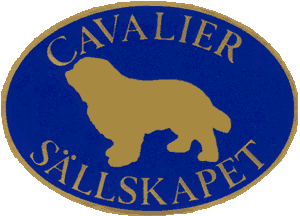 The Swedish Kennel Club (SKK) and the
Swedish Cavalier King Charles Spaniel
Club (SCKCS) began their CKCS crossbreeding project in June 2023. They
describe it as "carefully controlled by SCKCS and SKK, the breeding goal
is a breed typical cavalier but with a better genetic variation."
The Swedish Kennel Club (SKK) and the
Swedish Cavalier King Charles Spaniel
Club (SCKCS) began their CKCS crossbreeding project in June 2023. They
describe it as "carefully controlled by SCKCS and SKK, the breeding goal
is a breed typical cavalier but with a better genetic variation."
The clubs' reasoning for the program is that the breed is afflicted with "two serious diseases", mitral valve disease and syringomyelia. They have chosen for crossbreeding, the Lhasa Apso, Japanese spitz, and Danish-Swedish farm dog, which the say "are carefully selected due to the fact that they are far from the Cavalier genetically and are generally very healthy breeds."
All intended crossbreedings must be approved by the SCKCS. The intended parents must pass fairly stringent health tests. The cavalier's requirement are:
• Heart-wise better than the breed average, i.e. in addition to meeting the individual requirements of the Heart Program, the individual's parents must have a UA heart certificate after at least 6 years of age.
• Otherwise, no known serious genetic defects/diseases in first-line relatives, including symptomatic SM (parent, full sibling, offspring). Preferably have previous offspring.
• Healthy skull shape – not high risk when it comes to the Swedish Championships. The breeding animal should NOT show a short skull, dome-shaped high rounded head/forehead or poor hind skull.
The donor's requirements are:
• Heart UA after at least 3 years of age, the certificate must not be older than 1 year at the time of mating.
• Examined UA for any breed-specific defects/diseases, preferably with DNA tests where available. The individual must meet the registration requirements for the breed in question.
• No known serious genetic defects/diseases in first-line relatives (parent, full siblings, offspring).
• Healthy skull shape, see above.
• Fearless, open and friendly mentality. In cases where BPH exists, this will also be included in the assessment.
• Other: preferably be older, the individual must have been bred before.
Sweden's crossbreed matings began in late 2023. The SCKCS website lists the stati of various matings on a current basis. The website for Sweden's project is linked here.
RETURN TO TOP
Alternative to Crossbreeding
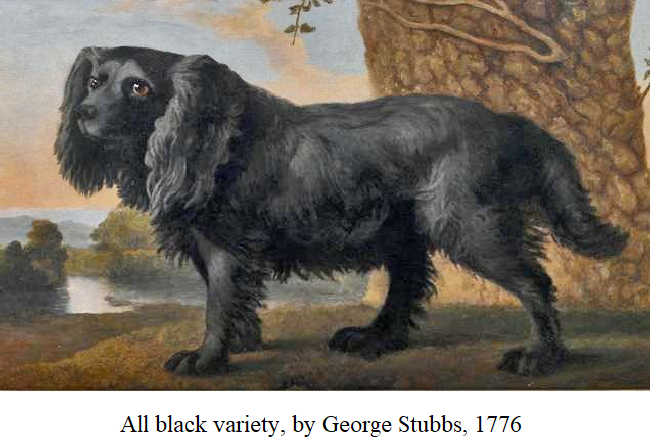 A possible alternative to crossbreeding cavaliers by outcrossing
them with other breeds, is to reinstate the cavaliers' other coat colors that
were removed from the UK Cavalier Club's breed standard in 1971.
Prior to then, CKCSs with coat colors which included black-&-white,
brown-&-white, brown-&-tan, and all black (right) were registerable as
purebed cavaliers in that national club. Among the first 18
cavaliers registered by the club in May 1945, 17% of them had coat
colors which no longer are permitted by the club's breed standard.
A possible alternative to crossbreeding cavaliers by outcrossing
them with other breeds, is to reinstate the cavaliers' other coat colors that
were removed from the UK Cavalier Club's breed standard in 1971.
Prior to then, CKCSs with coat colors which included black-&-white,
brown-&-white, brown-&-tan, and all black (right) were registerable as
purebed cavaliers in that national club. Among the first 18
cavaliers registered by the club in May 1945, 17% of them had coat
colors which no longer are permitted by the club's breed standard.
These "off-colors" were abundant among King Charles spaniels in earlier centuries. The 1651 painting of King Charles II above shows him holding a brown-&-white King Charles spaniel. Numerous other 17th and 18th and 19th century paintings have included off-color King Charles spaniels.
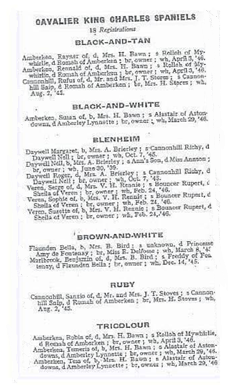 So the blood and the genes of these off-colors are part of the foundation
of the modern cavalier King Charles
spaniel. And, these off-color
cavaliers even were registered and shown in UK conformation shows as late as
the 1970s. (See list at right.)
So the blood and the genes of these off-colors are part of the foundation
of the modern cavalier King Charles
spaniel. And, these off-color
cavaliers even were registered and shown in UK conformation shows as late as
the 1970s. (See list at right.)
In 1971, Mrs. Amice Pitt (below, left) of the UK club wrote of her preference
for only the now-recognized four color combinations, and since then all CKCS
breed standards have adhered to her
 choices. This decision appears to have
been based solely upon personal preference without any thought to breed
health consequences. The elimination of the other colors clearly has had a
major damaging effect upon the breed's gene pool.
choices. This decision appears to have
been based solely upon personal preference without any thought to breed
health consequences. The elimination of the other colors clearly has had a
major damaging effect upon the breed's gene pool.
But limiting the official, recognized coat colors to just those four did not affect the genetic potential of the breed to continue to produce the off-color coats that had been in the breed for hundreds of years. Since 1971, purebred cavaliers have been bred to other purebred cavaliers and have produced offspring of black-&-whites, brown-&-whites, brown-&-tans, and all blacks. Since these varieties are not eligible to compete in CKCS conformation events, most all breeders have tried to eliminate such genes from their breeding stock. In most all cases, they have been successful, so the production of off-color cavaliers today is quite rare. But such offspring are not inconceivable, and a few breeders still find off-colors among their litters.
Susan Cochran, a long-time breeder of cavaliers in the United States, has
being finding “chocolate” colored
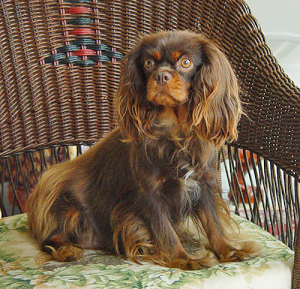 cavalier puppies in her
purebred CKCS litters since the
1980s. (See her “chocolate tan” Cochran’s Kitkat, at right.) She writes:
cavalier puppies in her
purebred CKCS litters since the
1980s. (See her “chocolate tan” Cochran’s Kitkat, at right.) She writes:
“In 1985, we purchased a very pretty Blenheim from Canada. She was from a mating of Can. Ch. Kilspindie Bryony of Beauchamps and Ch. Kindrum Simon of Silvercrest. Her name was Beauchamps Royal Flirtation and we called her “Flirt”. We found, years later, that Flirt was a carrier for the rare chocolate color gene that runs in the longevity bloodlines of Cavalier King Charles Spaniels. Flirt lived 15+ years and was a healthy, sweet, affectionate Cavalier. She is behind all of our dogs and was our foundation female. ... The Chocolate gene expresses itself as Chocolate Tan or Chocolate Tri. They are registered with AKC. I have also registered Chocolates with the CKCSC, USA.”
Since our concern primarily is with the health of cavaliers, we have looked into whether any purebred off-colors are more or less vulnerable to the disorders known to affect the CKCS, or even if the off-colors tend to develop other diseases to which the recognized colors seem immune. We have found no such evidence. The only differences between cavaliers of the “recognized” colored coats and the formerly recognized off-color coats are the colors of the coats. The recognized colors were chosen based solely upon personal preferences of such breeders as Mrs. Pitt, and not due to any health issues whatsoever.
Unfortunately, from a genetic health standpoint, the elimination of the off-colors has served as one more step in reducing the CKCS gene pool, which is very undesirable, as a general rule. In a September 2004 article, the investigators presented evidence that selection for coat color has not only narrowed the CKCS gene pool, but also has influenced the spread of Chiari-like malformation (CM) and syringomyelia (SM) throughout the breed.
It may be too late to rescue the CKCS breed from the deleterious health effects resulting from the elimination of the off-colors, but it is not too late to add them again. Considering that the only alternative approach to refreshing the gene pool has been to crossbreed with other breeds and then backcross, the insertion of off-color purebred cavaliers certainly is a less risky method of refreshing the gene pool.
RETURN TO TOP
Veterinary Resources
Some Practical Solutions to Welfare Problems in Dog Breeding. P D McGreevy, F W Nicholas. Anim.Welfare. August 1999; doi: 10.1017/S0962728600021965. Quote: This paper reviews the history of the establishment of dog breeds, summarizes current health and resultant welfare problems and makes some positive suggestions for their resolution. Some breed standards and selection practices run counter to the welfare interests of dogs, to the extent that some breeds are characterized by traits that may be difficult to defend on welfare grounds. Meanwhile, little selection pressure seems to be exerted on some traits that would improve animal welfare and produce dogs better suited to modern society. Unfortunately, the incidence of certain inherited defects in some breeds is unacceptably high, while the number of registered animals of certain breeds within some countries is so low as to make it almost impossible for breeders to avoid mating close relatives. There are several constructive ways to overcome these challenges. Breed associations can ensure that reduction of welfare problems is one of their major aims; they can review breed standards; they can embrace modern technology for animal identification and pedigree checking; they can allow the introduction of ‘new ‘ genetic material into closed stud-books; and they can encourage collaboration with geneticists in identifying and using DNA markers for the control of inherited disorders. There should be a concerted effort to produce and evaluate as companion animals first-cross (F1) hybrids from matings between various pairs of breeds. Finally, geneticists must learn to communicate their science better and in a language that non-geneticists can understand. ... Breed societies' rules should be changed in order to allow the introduction of 'new' genetic material into a breed. There should be a provision for crossing between two breeds, and then back crossing to the desired breed. After only three or four generations of back crossing with selection, the resultant animals will, for all practical purposes, be indistinguishable from pure-bred members of the breed. Yet, they will have received a healthy 'dose' of new genes which could help to reduce the incidence of inherited disorders that are common in a breed, especially if there is strong selection against the disorders during the back crossing process.
Inheritance of Chiari-Like Malformation: Can a Mixed Breeding Reduce the Risk of Syringomyelia. Susan P. Knowler, Henny van den Berg, Angus McFadyen, Roberto M. La Ragione, Clare Rusbridge. PLOSone. March 2016; doi: 10.1371/journal.pone.0151280. Quote: "Canine Chiari-like malformation (CM) is a complex abnormality of the skull and craniocervical junction associated with miniaturization and brachycephaly which can result in the spinal cord disease syringomyelia (SM). ... The heritability of SM has been estimated in the Cavalier King Charles Spaniel (CKCS) as moderately high (h2 = 0.37 ± 0.15 standard error) and prevalence increases with age. CM is ubiquitous in the CKCS and has an estimated prevalence of 65% in Griffon Bruxellois (GB). One study investigating the breeding programme of CKCS (n = 550) and GB (n = 93) found 70% and 73% respectively of offspring were free of SM if their parents were SM clear over 5 years of age but when both parents were SM affected the risk of SM was 92% in CKCS and 100% GB. ... This study investigated the inheritance of CM in a Griffon Bruxellois (GB) family and feasibility of crossbreeding a brachycephalic CM affected GB with a mesaticephalic normal Australian terrier and then backcrossing to produce individuals free of the malformation and regain GB breed characteristics. The study family cohort (n = 27) included five founder dogs from a previous baseline study of 155 GB which defined CM as a global malformation of the cranium and craniocervical junction with a shortened skull base and increased proximity of the cervical vertebrae to the skull. T1-weighted sagittal DICOM images of the brain and craniocervical junction were analysed for five significant traits (two angles, three lines) identified from the previous study and subsequent Qualitative Trait Loci analysis. Mean measurements for mixed breed, pure-breed and baseline study groups were compared. Results indicated that mixed breed traits posed less risk for CM and SM and were useful to distinguish the phenotype. Moreover on the MR images, the filial relationships displayed by the traits exhibited segregation and those presenting the greatest risk for CM appeared additive towards the severity of the condition. The external phenotypes revealed that by outcrossing breed types and with careful selection of appropriate conformation characteristics in the first generation, it is possible to regain the GB breed standard and reduce the degree of CM. The four GB affected with SM in the study all exhibited reduced caudal skull development compared to their relatives. The craniocervical traits may be useful for quantifying CM and assessing the possibility of SM thus assisting breeders with mate selection. However, such a system requires validation to ensure appropriateness for all breeds at risk.


CONNECT WITH US